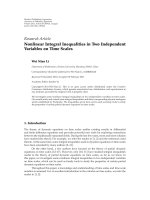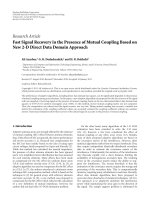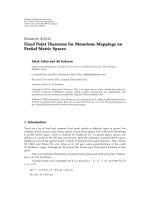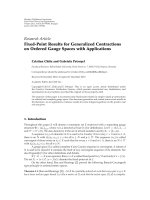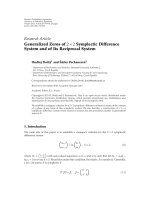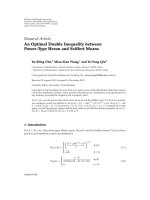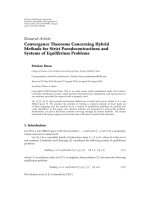báo cáo hóa học:" Research Article Fixed Point Results in Quasimetric Spaces Abdul Latif and Saleh A. Al-Mezel" pdf
Bạn đang xem bản rút gọn của tài liệu. Xem và tải ngay bản đầy đủ của tài liệu tại đây (470.84 KB, 8 trang )
Hindawi Publishing Corporation
Fixed Point Theory and Applications
Volume 2011, Article ID 178306, 8 pages
doi:10.1155/2011/178306
Research Article
Fixed Point Results in Quasimetric Spaces
Abdul Latif and Saleh A. Al-Mezel
Department of Mathematics, King Abdulaziz University, P. O. Box 80203, Jeddah 21589, Saudi Arabia
Correspondence should be addressed to Abdul Latif,
Received 21 August 2010; Accepted 5 October 2010
Academic Editor: Qamrul Hasan Ansari
Copyright q 2011 A. Latif and S. A. Al-Mezel. This is an open access article distributed under
the Creative Commons Attribution License, which permits unrestricted use, distribution, and
reproduction in any medium, provided the original work is properly cited.
In the setting of quasimetric spaces, we prove some new results on the existence of fixed points for
contractive type maps with respect to Q-function. Our results either improve or generalize many
known results in the literature.
1. Introduction and Preliminaries
Let X be a metric space with metric d.WeuseSX to denote the collection of all nonempty
subsets of X, ClX for the collection of all nonempty closed subsets of X, CBX for the
collection of all nonempty closed bounded subsets of X, and H for the Hausdorff metric
on CBX, that is,
H
A, B
max
sup
a∈A
d
a, B
, sup
b∈B
d
b, A
,A,B∈ CB
X
, 1.1
where da, Binf{da, b : b ∈ B} is the distance from the point a to the subset B.
For a multivalued map T : X → CBX,wesay
aT is contraction 1 if there exists a constant λ ∈ 0, 1, such that for all x, y ∈ X,
H
T
x
,T
y
≤ λd
x, y
, 1.2
bT is weakly contractive 2 if there exist constants h, b ∈ 0,
1,h<b, such that for
any x ∈ X, there is y ∈ I
x
b
satisfying
d
y, T
y
≤ hd
x, y
, 1.3
where I
x
b
{y ∈ Tx : bdx, y ≤ dx, Tx}.
2 Fixed Point Theory and Applications
Apointx ∈ X is called a fixed point of a multivalued map T : X → SX if x ∈ Tx.
We denote FixT{x ∈ X : x ∈ Tx}.
A sequence {x
n
} in X is called an orbit of T at x
0
∈ X if x
n
∈ Tx
n−1
for all integer
n ≥ 1. A real valued function f on X is called lower semicontinuous if for any sequence {x
n
}⊂X
with x
n
→ x ∈ X implies that fx ≤ lim inf
n →∞
fx
n
.
Using the Hausdorff metric, Nadler Jr. 1 has established a multivalued version of the
well-known Banach contraction principle in the setting of metric spaces as follows.
Theorem 1.1. Let X, d be a complete metric space, then each contraction map T : X → CBX
has a fixed point.
Without using the Hausdorff metric, Feng and Liu 2 generalized Nadler’s
contraction principle as follows.
Theorem 1.2. Let X, d be a complete metric space and let T : X → ClX be a weakly contractive
map, then T has a fixed point in X provided the real valued function fxdx, Tx on X is a
lower semicontinuous.
In 3, Kada et al. introduced the concept of w-distance in the setting of metric spaces
as follows.
A function ω : X × X → 0, ∞ is called a w-distance on X if it satisfies the following:
w1 ωx, z ≤ ω
x, yωy, z, for all x, y, z ∈ X;
w2 ω is lower semicontinuous in its second variable;
w3 for any ε>0, there exists δ>0, such that ωz, x ≤ δ and ωz, y ≤ δ imply
dx, y ≤ ε.
Note that in general for x,y ∈ X, ωx, y
/
ωy, x and not either of the implications
ωx, y0 ⇔ x y necessarily holds. Clearly, the metric d is a w-distance on X. Many other
examples and properties of w-distances are given in 3.
In 4, Suzuki and Takahashi improved Nadler contraction principle Theorem 1.1 as
follows.
Theorem 1.3. Let X, d
be a complete metric space and let T : X → ClX.Ifthereexistaw-
distance ω on X and a constant λ ∈ 0, 1, such that for each x, y ∈ X and u ∈ Tx,thereis
v ∈ Ty satisfying
ω
u, v
≤ λω
x, y
, 1.4
then T has a fixed point.
Recently, Latif and Albar 5 generalized Theorem 1.2 with respect to w-distance see,
Theorem 3.3in5,andLatif6 proved a fixed point result with respect to w-distance see,
Theorem 2.2in6 which contains Theorem 1.3 as a special case.
A nonempty set X together with a quasimetric d i.e., not necessarily symmetric
is called a quasimetric space. In the setting of a quasimetric spaces, Al-Homidan et al. 7
introduced the concept of a Q-function on quasimetric spaces which generalizes the notion
of a w-distance.
Fixed Point Theory and Applications 3
A function q : X × X → 0, ∞ is called a Q-function on X if it satisfies the following
conditions:
Q1 qx, z ≤ qx, yqy, z, for all x, y, z ∈ X;
Q2 If {y
n
} is a sequence in X such that y
n
→ y ∈ X and for x ∈ X, qx, y
n
≤ M for
some M Mx > 0, then qx, y ≤ M,
Q3 for any ε>0, there exists δ>0, such that qx, y ≤ δ and qx, z ≤ δ imply
dy, z ≤ ε.
Note that every w-distance is a Q-function, but the converse is not true in general 7.
Now, we state some useful properties of Q-function as given in 7.
Lemma 1.4. Let X, d be a complete quasimetric space and let q be a Q-function on X.Let{x
n
} and
{y
n
} be sequences in X.Let{α
n
} and {β
n
} be sequences in 0, ∞ converging to 0, then the following
hold for any x, y, z ∈ X:
i if qx
n
,y ≤ α
n
and qx
n
,z ≤ β
n
for all n ≥ 1, then y z; in particular, if qx, y0
and qx, z0,theny z;
ii if qx
n
,y
n
≤ α
n
and qx
n
,z ≤ β
n
for all n ≥ 1, then {y
n
} converges to z;
iii if qx
n
,x
m
≤ α
n
for any n, m ≥ 1 with m>n,then {x
n
} is a Cauchy sequence;
iv if qy, x
n
≤ α
n
for any n ≥ 1, then {x
n
} is a Cauchy sequence.
Using the concept Q-function, Al-Homidan et al. 7 recently studied an equilibrium
version of the Ekeland-type variational principle. They also generalized Nadler’s fixed point
theorem Theorem 1.1 in the setting of quasimetric spaces as follows.
Theorem 1.5. Let X, d be a complete quasimetric space and let T : X → ClX.Ifthereexist
Q-function q on X and a constant λ ∈ 0, 1, such that for each x, y ∈ X and u ∈ Tx,thereis
v ∈ Ty satisfying
q
u, v
≤ λq
x, y
, 1.5
then T has a fixed point.
In the sequel, we consider X as a quasimetric space with quasimetric d.
Considering a multivalued map T : X → SX,wesay
c T is weakly q-contractive
if there exist Q-function q on X and constants h, b ∈ 0, 1,
h<b, such that for any x ∈ X, there is y ∈ J
x
b
satisfying
q
y, T
y
≤ hq
x, y
, 1.6
where J
x
b
{y ∈ Tx : bqx, y ≤ qx, Tx} and qx, Tx inf{qx, y : y ∈ Tx};
d T is generalized q-contractive if there exists a Q-function q on X, such that for each
x, y ∈ X and u ∈ Tx, there is v ∈ Ty satisfying
q
u, v
≤ k
q
x, y
q
x, y
, 1.7
where k is a function of 0
, ∞ to 0, 1, such that lim sup
r → t
kr < 1 for all t ≥ 0.
4 Fixed Point Theory and Applications
Clearly, the class of weakly q-contractive maps contains the class of weakly contractive
maps, and the class of generalized q-contractive maps contains the classes of generalized
ω-contraction maps 6, ω-contractive maps 4,andq-contractive maps 7.
In this paper, we prove some new fixed point results in the setting of quasimetric
spaces for weakly q-contractive and generalized q-contractive multivalued maps. Conse-
quently, our results either improve or generalize many known results including the above
stated fixed point results.
2. The Results
First, we prove a fixed point theorem for weakly q-contractive maps in the setting of
quasimetric spaces.
Theorem 2.1. Let X be a complete quasimetric space and let T : X → ClX be a weakly q-
contractive map. If a real valued function fxqx, Tx on X is lower semicontinuous, then
there exists v
o
∈ X, such that qv
o
,Tv
o
0. Further, if qv
o
,v
o
0, then v
0
is a fixed point of
T.
Proof. Let x
o
∈ X. Since T is weakly contractive, there is x
1
∈ J
x
o
b
⊆ Tx
o
, such that
q
x
1
,T
x
1
≤ hq
x
o
,x
1
, 2.1
where h<b.Continuing this process, we can get an orbit {x
n
} of T at x
o
satisfying x
n1
∈ J
x
n
b
and
q
x
n1
,T
x
n1
≤ h
x
n
,x
n1
,n 0, 1, 2, 2.2
Since bqx
n
,x
n1
≤ qx
n
,Tx
n
and h<b<1, thus we get
q
x
n1
,T
x
n1
≤ q
x
n
,T
x
n
. 2.3
If we put a h/b, t hen also we have
q
x
n1
,T
x
n1
≤ aq
x
n
,T
x
n
. 2.4
Thus, we obtain
q
x
n
,T
x
n
≤ a
n
q
x
o
,T
x
0
,n 0, 1, 2, , 2.5
and since 0 <a<1, hence the sequence {fx
n
} {qx
n
,Tx
n
}, which is decreasing,
converges to 0. Now, we show that {x
n
} is a Cauchy sequence. Note that
q
x
n
,x
n1
≤ a
n
q
x
o
,x
1
,n 0, 1, 2, 2.6
Fixed Point Theory and Applications 5
Now, for any integer n, m ≥ 1withm>n, we have
q
x
n
,x
m
≤ q
x
n
,x
n1
q
x
n1
,x
n2
··· q
x
m−1
,x
m
≤ a
n
q
x
o
,x
1
a
n1
q
x
o
,x
1
··· a
m−1
q
x
o
,x
1
≤
a
n
1 − a
q
x
o
,x
1
,
2.7
and thus by Lemma 1.4, {x
n
} is a Cauchy sequence. Due to the completeness of X, there exists
some v
0
∈ X, such that lim
n →∞
x
n
v
o
. Now, since f is lower semicontinuous, we have
0 ≤ f
v
o
≤ lim inf
n →∞
f
x
n
0, 2.8
and thus, fv
o
qv
o
,Tv
o
0. It follows that there exists a sequence {v
n
} in Tv
0
,
such that qv
0
,v
n
→ 0. Now, if qv
o
,v
o
0, then by Lemma 1.4, v
n
→ v
0
. Since Tv
0
is
closed, we get v
0
∈ Tv
0
.
Now, we prove the following useful lemma.
Lemma 2.2. Let X, d be a complete quasimetric space and let T : X → ClX be a generalized
q-contractive map, then there exists an orbit {x
n
} of T at x
0
, such that the sequence of nonnegative
numbers {qx
n
,x
n1
} is decreasing to zero and {x
n
} is a Cauchy sequence.
Proof. Let x
o
be an arbitrary but fixed element of X and let x
1
∈ Tx
0
. Since T is generalized
as a q-contractive, there is x
2
∈ Tx
1
, such that
q
x
1
,x
2
≤ k
q
x
o
,x
1
q
x
o
,x
1
. 2.9
Continuing this process, we get a sequence {x
n
} in X, such that x
n1
∈ Tx
n
and
q
x
n
,x
n1
≤ k
q
x
n−1
,x
n
q
x
n−1
,x
n
. 2.10
Thus, for all n ≥ 1, we have
q
x
n
,x
n1
<q
x
n−1
,x
n
. 2.11
Write t
n
qx
n
,x
n1
. Suppose that lim
n →∞
t
n
λ>0, then we have
t
n
≤ k
t
n−1
t
n−1
. 2.12
Now, taking limits as n →∞on both sides, we get
λ ≤ lim sup
n →∞
k
t
n−1
λ<λ, 2.13
6 Fixed Point Theory and Applications
which is not possible, and hence the sequence of nonnegative numbers {t
n
}, which is
decreasing, converges to 0. Finally, we show that {x
n
} is a Cauchy sequence. Let α
lim sup
r → 0
kr < 1. There exists real number β such that α<β<1. Then for sufficiently
large n, kt
n
<β,andthusforsufficiently large n, we have t
n
<βt
n−1
. Consequently, we
obtain t
n
<β
n
t
0
,thatis,
q
x
n
,x
n1
<β
n
q
x
o
,x
1
,n 0, 1, 2, 2.14
Now, for any integers n, m ≥ 1,m>n,
q
x
n
,x
m
≤ q
x
n
,x
n1
q
x
n1
,x
n2
··· q
x
m−1
,x
m
<β
n
q
x
o
,x
1
β
n1
q
x
o
,x
1
··· β
m−1
q
x
o
,x
1
<
β
n
1 − β
q
x
o
,x
1
,
2.15
and thus by Lemma 1.4, {x
n
} is a Cauchy sequence.
Applying Lemma 2.2, we prove a fixed point result for generalized q-contractive maps.
Theorem 2.3. Let X, d be a complete quasimetric space then each generalized q -contractive map
T : X → ClX has a fixed point.
Proof. It follows from Lemma 2.2 that there exists a Cauchy sequence {x
n
} in X such that the
decreasing sequence {qx
n
,x
n1
} converges to 0. Due to the completeness of X, there exists
some v
0
∈ X such that lim
n →∞
x
n
v
o
. Let n be arbitrary fixed positive integer then for all
positive integers m with m>n, we have
q
x
n
,x
m
≤
β
n
1 − β
q
x
o
,x
1
. 2.16
Let M β
n
/1 − βqx
0
,x
1
, then M ≥ 0. Now, note that
q
x
n
,x
m
≤ M ⇒ q
x
n
,v
0
≤ M. 2.17
Since n was arbitrary fixed, we have
q
x
n
,v
0
≤
β
n
1 − β
q
x
o
,x
1
, for all positive integer n. 2.18
Note that qx
n
,v
o
converges to 0. Now, since x
n
∈ Tx
n−1
and T is a generalized q-
contractive map, then there is u
n
∈ Tv
0
, such that
q
x
n
,u
n
≤ k
q
x
n−1
,v
0
q
x
n−1
,v
0
. 2.19
Fixed Point Theory and Applications 7
And for large n,weobtain
q
x
n
,u
n
≤ k
q
x
n−1
,v
0
q
x
n−1
,v
0
<βq
x
n−1
,v
0
, 2.20
thus, we get
q
x
n
,u
n
<βq
x
n−1
,v
0
≤
β
n
1 − β
q
x
o
,x
1
. 2.21
Thus, it follows from Lemma 1.4 that u
n
→ v
0
. Since Tv
0
is closed, we get v
0
∈ Tv
0
.
Corollary 2.4. Let X, d be a complete quasimetric space and q a Q-function on X.LetT : X →
ClX be a multivalued map, such that for any x, y ∈ X and u ∈ Tx,thereisv ∈ Ty with
q
u, v
≤ k
q
x, y
q
x, y
, 2.22
where k is a monotonic increasing function from 0, ∞ to 0, 1,thenT has a fixed point.
Finally, we conclude with the following remarks concerning our results related to the
known fixed point results.
Remark 2.5. 1Theorem 2.1 generalizes Theorem 1.2 according to Feng and Liu 2 and Latif
and Albar 5, Theorem 3.3.
2Theorem 2.3
generalizes Theorem 1.3 according to Suzuki and Takahashi 4 and
Theorem 1.5 according to Al-Homidan et al. 7 and contains Latif’s Theorem 2.2in6.
3Theorem 2.3 also generalizes Theorem 2.1in8 in several ways.
4Corollary 2.4 improves and generalizes Theorem 1 in 9.
Acknowledgments
The authors thank t he referees for their kind comments. The authors also thank King
Abdulaziz University and the Deanship of Scientific Research for the research Grant no. 3-
35/429.
References
1 S. B. Nadler Jr., “Multi-valued contraction mappings,” Pacific Journal of Mathematics, vol. 30, pp. 475–
488, 1969.
2 Y. Feng and S. Liu, “Fixed point theorems for multi-valued contractive mappings and multi-valued
Caristi type mappings,” Journal of Mathematical Analysis and Applications, vol. 317, no. 1, pp. 103–112,
2006.
3 O. Kada, T. Suzuki, and W. Takahashi, “Nonconvex minimization theorems and fixed point theorems
in complete metric spaces,” Mathematica Japonica, vol. 44, no. 2, pp. 381–391, 1996.
4 T. Suzuki and W. Takahashi, “Fixed point theorems and characterizations of metric completeness,”
Topological Methods in Nonlinear Analysis, vol. 8, no. 2, pp. 371–382, 1997.
5 A. Latif and W. A. Albar, “Fixed point results in complete metric spaces,” Demonstratio Mathematica,
vol. 41, no. 1, pp. 145–150, 2008.
8 Fixed Point Theory and Applications
6 A. Latif, “A fixed point result in complete metric spaces,” JP Journal of Fixed Point Theory and
Applications, vol. 2, no. 2, pp. 169–175, 2007.
7 S. Al-Homidan, Q. H. Ansari, and J C. Yao, “Some generalizations of Ekeland-type variational
principle with applications to equilibrium problems and fixed point theory,” Nonlinear Analysis: Theory,
Methods & Applications, vol. 69, no. 1, pp. 126–139, 2008.
8 A. H. Siddiqi and Q. H. Ansari, “An iterative method for generalized variational inequalities,”
Mathematica Japonica, vol. 34, no. 3, pp. 475–481, 1989.
9 H. Kaneko, “Generalized contractive multivalued mappings and their fixed points,” Mathematica
Japonica, vol. 33, no. 1, pp. 57–64, 1988.
